Microeconomics Eco 101: Exploring Price Elasticity and its Impact
VerifiedAdded on 2024/06/27
|12
|2148
|162
Homework Assignment
AI Summary
This assignment solution delves into the concept of price elasticity of demand and supply, differentiating between elastic and inelastic demand. It explores how the slope of the demand curve and elasticity relate to changes in consumer demand due to price fluctuations, highlighting their differences and behavior under various conditions, including negatively sloped, vertical, and horizontal demand curves. The role of substitution in determining elasticity is examined, outlining conditions that lead to more elastic demand. Furthermore, the solution analyzes the impact of price changes on a firm's total revenue under both elastic and inelastic demand scenarios, providing a thorough understanding of these key microeconomic principles. Desklib offers a wealth of similar resources for students seeking academic support.
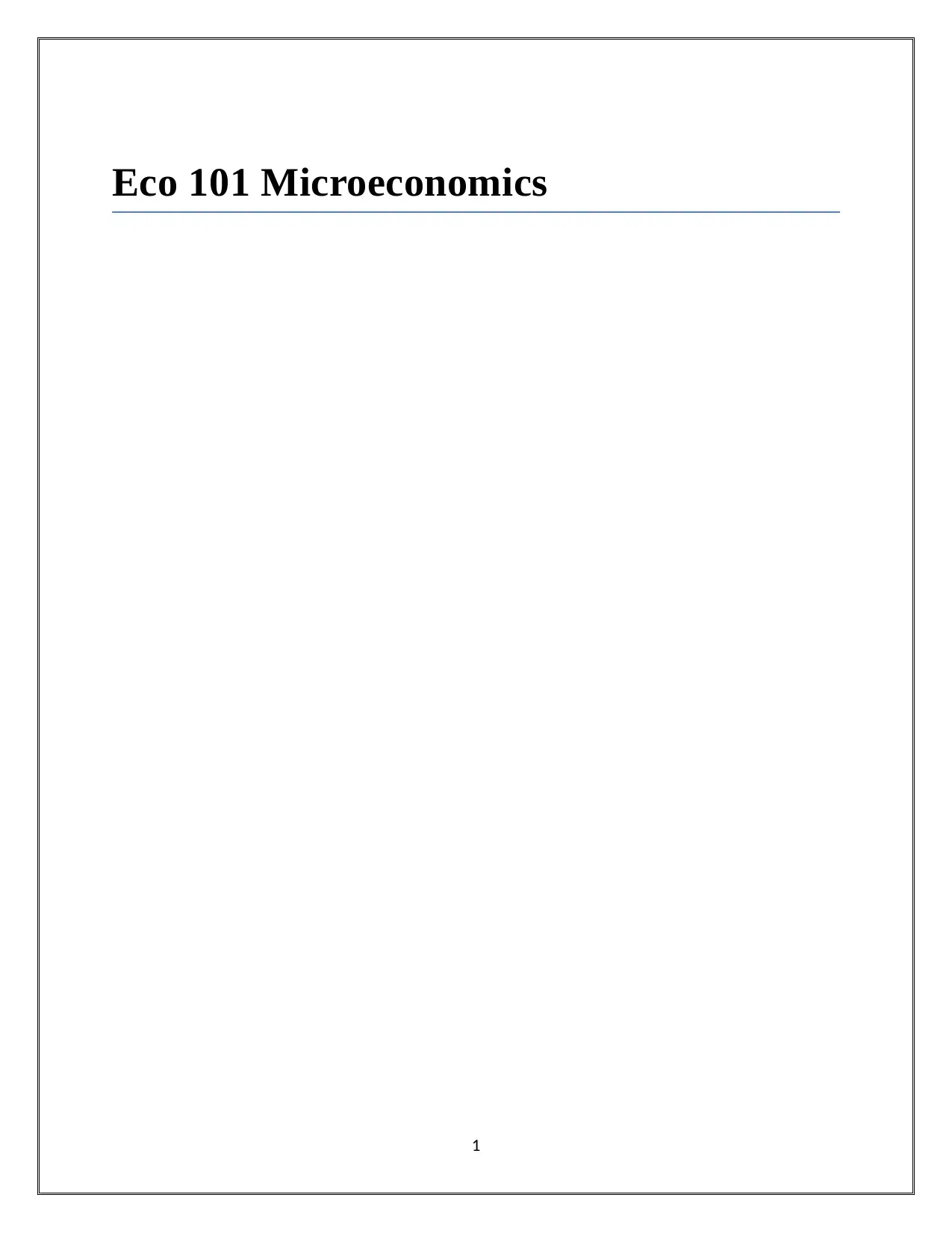
Eco 101 Microeconomics
1
1
Paraphrase This Document
Need a fresh take? Get an instant paraphrase of this document with our AI Paraphraser
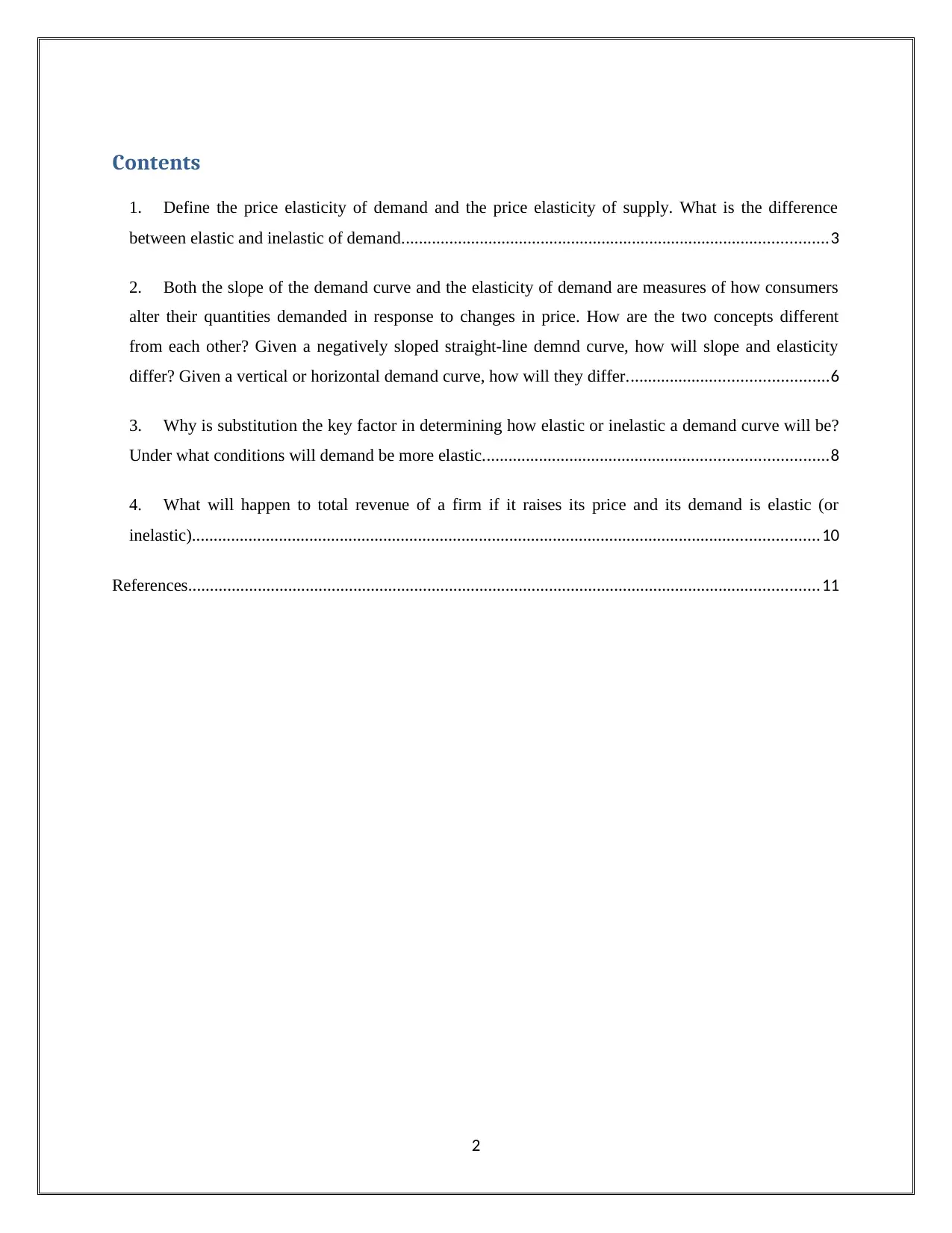
Contents
1. Define the price elasticity of demand and the price elasticity of supply. What is the difference
between elastic and inelastic of demand..................................................................................................3
2. Both the slope of the demand curve and the elasticity of demand are measures of how consumers
alter their quantities demanded in response to changes in price. How are the two concepts different
from each other? Given a negatively sloped straight-line demnd curve, how will slope and elasticity
differ? Given a vertical or horizontal demand curve, how will they differ..............................................6
3. Why is substitution the key factor in determining how elastic or inelastic a demand curve will be?
Under what conditions will demand be more elastic...............................................................................8
4. What will happen to total revenue of a firm if it raises its price and its demand is elastic (or
inelastic)................................................................................................................................................10
References.................................................................................................................................................11
2
1. Define the price elasticity of demand and the price elasticity of supply. What is the difference
between elastic and inelastic of demand..................................................................................................3
2. Both the slope of the demand curve and the elasticity of demand are measures of how consumers
alter their quantities demanded in response to changes in price. How are the two concepts different
from each other? Given a negatively sloped straight-line demnd curve, how will slope and elasticity
differ? Given a vertical or horizontal demand curve, how will they differ..............................................6
3. Why is substitution the key factor in determining how elastic or inelastic a demand curve will be?
Under what conditions will demand be more elastic...............................................................................8
4. What will happen to total revenue of a firm if it raises its price and its demand is elastic (or
inelastic)................................................................................................................................................10
References.................................................................................................................................................11
2

1. Define the price elasticity of demand and the price elasticity of supply. What is the
difference between elastic and inelastic of demand.
The price elasticity of demand is relatively inelastic is the percentage change in quantity
demanded is smaller than that of the price (Tutor2U, 2018). It also depicts the correlation
between the price and number demanded and also shows that how the change in one affect the
change in other one.
Image: Price Elasticity Graph
Source: Economics Online, 2018
Price elasticity of demand= % change in quantity demanded/ % change in price
This calculation is done so as to evaluate the effect of price change on the quantity demanded
and on the revenue which is received by the firms (Economics Online, 2018).
Price elasticity of supply is used to show the receptiveness of the quantity supplied of a good to
the altered price of goods and services. It takes into considerations various determinants such as
time to respond, availability of raw materials and inventories (Economics Online, 2018).
3
difference between elastic and inelastic of demand.
The price elasticity of demand is relatively inelastic is the percentage change in quantity
demanded is smaller than that of the price (Tutor2U, 2018). It also depicts the correlation
between the price and number demanded and also shows that how the change in one affect the
change in other one.
Image: Price Elasticity Graph
Source: Economics Online, 2018
Price elasticity of demand= % change in quantity demanded/ % change in price
This calculation is done so as to evaluate the effect of price change on the quantity demanded
and on the revenue which is received by the firms (Economics Online, 2018).
Price elasticity of supply is used to show the receptiveness of the quantity supplied of a good to
the altered price of goods and services. It takes into considerations various determinants such as
time to respond, availability of raw materials and inventories (Economics Online, 2018).
3
⊘ This is a preview!⊘
Do you want full access?
Subscribe today to unlock all pages.

Trusted by 1+ million students worldwide

Image: Elasticity of Supply
Source: Tutor2U, 2018
Price Elasticity of Supply= % change in quantity supplied/ % change in price
There are three cases such as:
The perfectly elastic where the supply of goods in infinite at the particular price.
Perfectly Inelastic where only single quantity can be supplied.
Unitary elastic where the elasticity is 1 (Difference, 2017).
Difference between elastic and inelastic demand
4
Source: Tutor2U, 2018
Price Elasticity of Supply= % change in quantity supplied/ % change in price
There are three cases such as:
The perfectly elastic where the supply of goods in infinite at the particular price.
Perfectly Inelastic where only single quantity can be supplied.
Unitary elastic where the elasticity is 1 (Difference, 2017).
Difference between elastic and inelastic demand
4
Paraphrase This Document
Need a fresh take? Get an instant paraphrase of this document with our AI Paraphraser
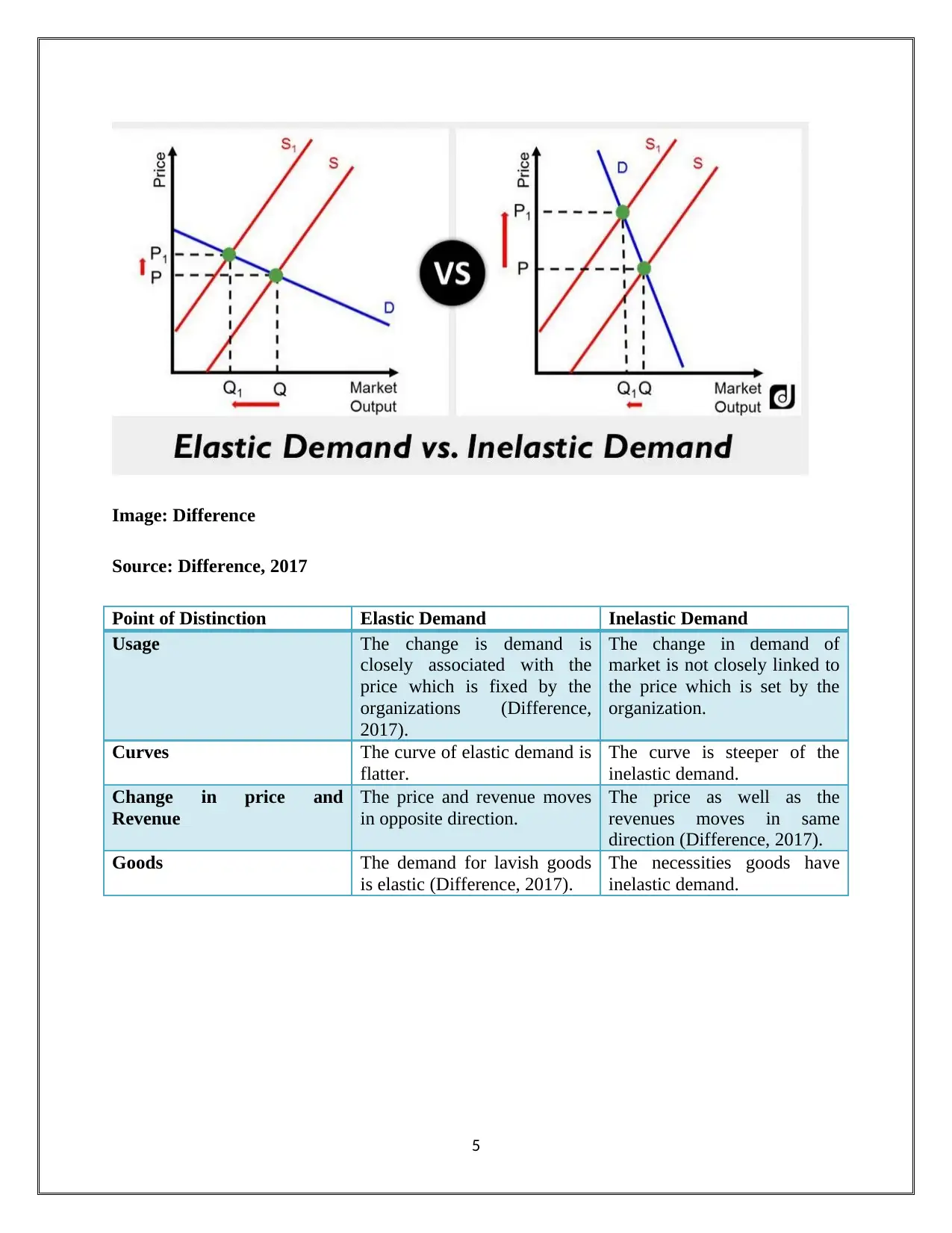
Image: Difference
Source: Difference, 2017
Point of Distinction Elastic Demand Inelastic Demand
Usage The change is demand is
closely associated with the
price which is fixed by the
organizations (Difference,
2017).
The change in demand of
market is not closely linked to
the price which is set by the
organization.
Curves The curve of elastic demand is
flatter.
The curve is steeper of the
inelastic demand.
Change in price and
Revenue
The price and revenue moves
in opposite direction.
The price as well as the
revenues moves in same
direction (Difference, 2017).
Goods The demand for lavish goods
is elastic (Difference, 2017).
The necessities goods have
inelastic demand.
5
Source: Difference, 2017
Point of Distinction Elastic Demand Inelastic Demand
Usage The change is demand is
closely associated with the
price which is fixed by the
organizations (Difference,
2017).
The change in demand of
market is not closely linked to
the price which is set by the
organization.
Curves The curve of elastic demand is
flatter.
The curve is steeper of the
inelastic demand.
Change in price and
Revenue
The price and revenue moves
in opposite direction.
The price as well as the
revenues moves in same
direction (Difference, 2017).
Goods The demand for lavish goods
is elastic (Difference, 2017).
The necessities goods have
inelastic demand.
5

2. Both the slope of the demand curve and the elasticity of demand are measures of how
consumers alter their quantities demanded in response to changes in price. How are the
two concepts different from each other? Given a negatively sloped straight-line demand
curve, how will slope and elasticity differ? Given a vertical or horizontal demand curve,
how will they differ.
Yes, both the slope of demand curve as well as the elasticity of demand show that how the
customers change their quantity demanded with the change in price. But these two concepts are
different from each other as:
Image: The slope of price elasticity and the slope of demand curve
Source: Economic Online, 2018
It can be seen that the demand curve is the simple linear demand curve where the slope of
demand is constant and the Elasticities at each point is different (Economics Online, 2018). So,
here the formula for the demand curve is positive. The decrease in price is showing the increase
is quantity demanded. So, it can be said that the elasticity of demand isn’t related to the slope of
6
consumers alter their quantities demanded in response to changes in price. How are the
two concepts different from each other? Given a negatively sloped straight-line demand
curve, how will slope and elasticity differ? Given a vertical or horizontal demand curve,
how will they differ.
Yes, both the slope of demand curve as well as the elasticity of demand show that how the
customers change their quantity demanded with the change in price. But these two concepts are
different from each other as:
Image: The slope of price elasticity and the slope of demand curve
Source: Economic Online, 2018
It can be seen that the demand curve is the simple linear demand curve where the slope of
demand is constant and the Elasticities at each point is different (Economics Online, 2018). So,
here the formula for the demand curve is positive. The decrease in price is showing the increase
is quantity demanded. So, it can be said that the elasticity of demand isn’t related to the slope of
6
⊘ This is a preview!⊘
Do you want full access?
Subscribe today to unlock all pages.

Trusted by 1+ million students worldwide
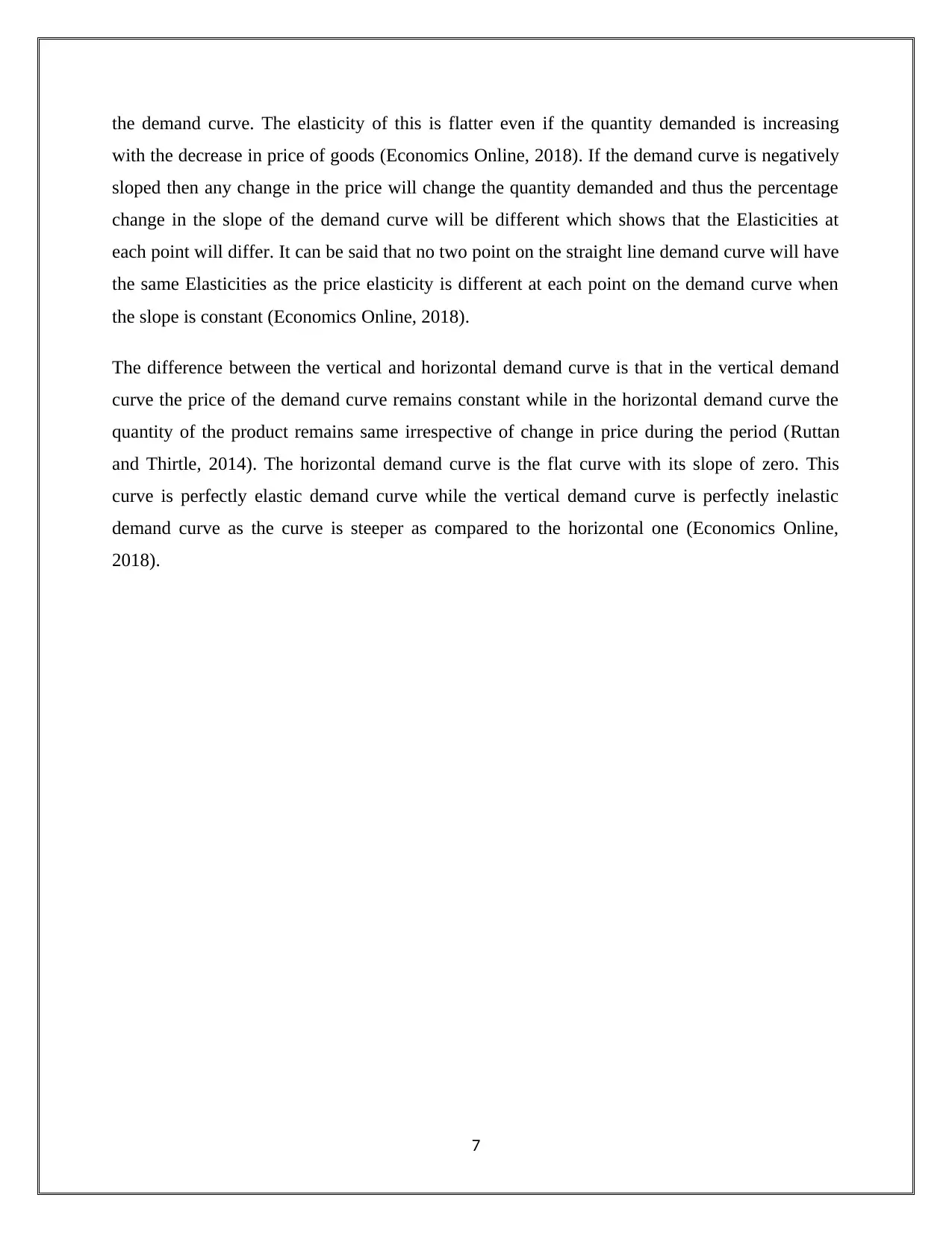
the demand curve. The elasticity of this is flatter even if the quantity demanded is increasing
with the decrease in price of goods (Economics Online, 2018). If the demand curve is negatively
sloped then any change in the price will change the quantity demanded and thus the percentage
change in the slope of the demand curve will be different which shows that the Elasticities at
each point will differ. It can be said that no two point on the straight line demand curve will have
the same Elasticities as the price elasticity is different at each point on the demand curve when
the slope is constant (Economics Online, 2018).
The difference between the vertical and horizontal demand curve is that in the vertical demand
curve the price of the demand curve remains constant while in the horizontal demand curve the
quantity of the product remains same irrespective of change in price during the period (Ruttan
and Thirtle, 2014). The horizontal demand curve is the flat curve with its slope of zero. This
curve is perfectly elastic demand curve while the vertical demand curve is perfectly inelastic
demand curve as the curve is steeper as compared to the horizontal one (Economics Online,
2018).
7
with the decrease in price of goods (Economics Online, 2018). If the demand curve is negatively
sloped then any change in the price will change the quantity demanded and thus the percentage
change in the slope of the demand curve will be different which shows that the Elasticities at
each point will differ. It can be said that no two point on the straight line demand curve will have
the same Elasticities as the price elasticity is different at each point on the demand curve when
the slope is constant (Economics Online, 2018).
The difference between the vertical and horizontal demand curve is that in the vertical demand
curve the price of the demand curve remains constant while in the horizontal demand curve the
quantity of the product remains same irrespective of change in price during the period (Ruttan
and Thirtle, 2014). The horizontal demand curve is the flat curve with its slope of zero. This
curve is perfectly elastic demand curve while the vertical demand curve is perfectly inelastic
demand curve as the curve is steeper as compared to the horizontal one (Economics Online,
2018).
7
Paraphrase This Document
Need a fresh take? Get an instant paraphrase of this document with our AI Paraphraser
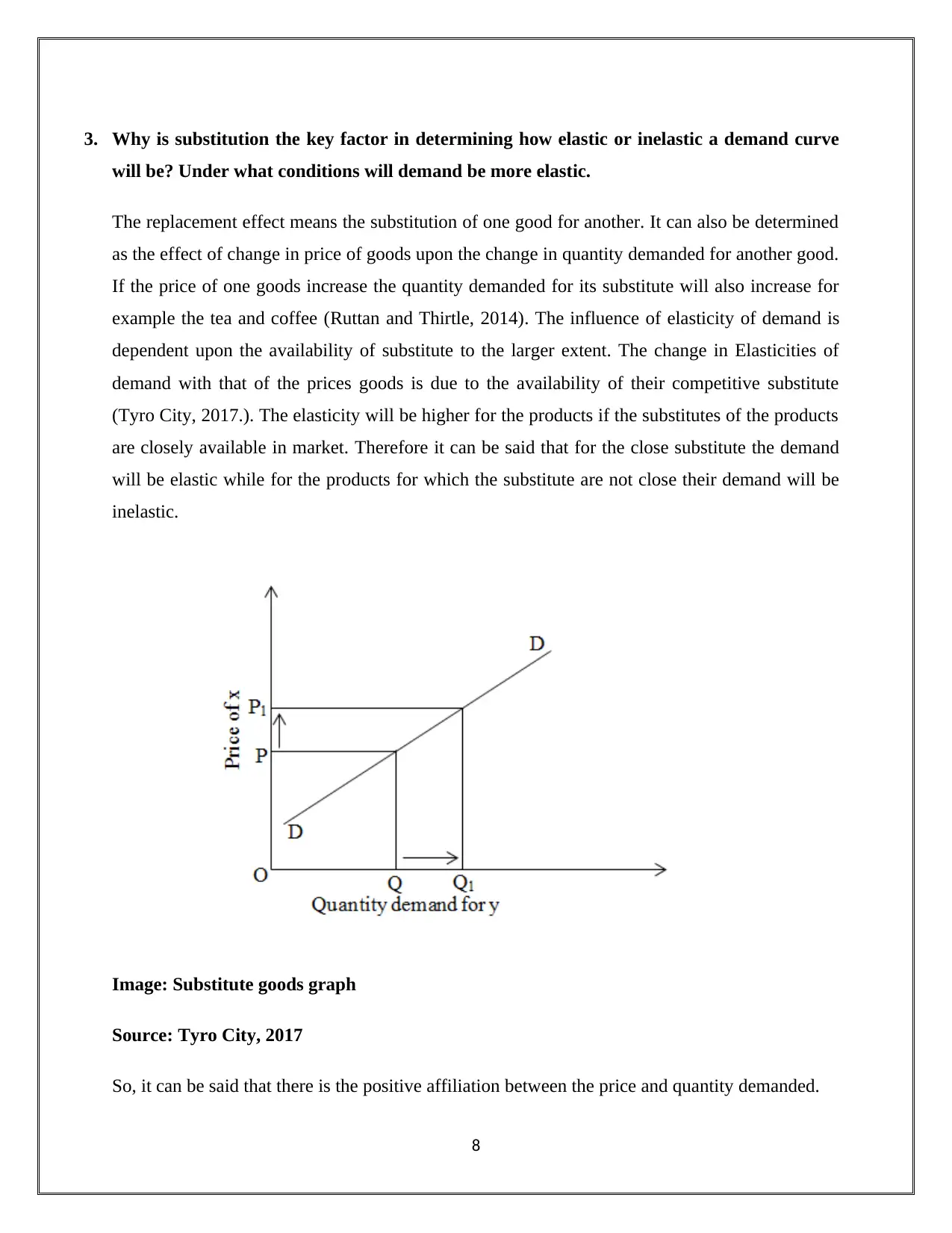
3. Why is substitution the key factor in determining how elastic or inelastic a demand curve
will be? Under what conditions will demand be more elastic.
The replacement effect means the substitution of one good for another. It can also be determined
as the effect of change in price of goods upon the change in quantity demanded for another good.
If the price of one goods increase the quantity demanded for its substitute will also increase for
example the tea and coffee (Ruttan and Thirtle, 2014). The influence of elasticity of demand is
dependent upon the availability of substitute to the larger extent. The change in Elasticities of
demand with that of the prices goods is due to the availability of their competitive substitute
(Tyro City, 2017.). The elasticity will be higher for the products if the substitutes of the products
are closely available in market. Therefore it can be said that for the close substitute the demand
will be elastic while for the products for which the substitute are not close their demand will be
inelastic.
Image: Substitute goods graph
Source: Tyro City, 2017
So, it can be said that there is the positive affiliation between the price and quantity demanded.
8
will be? Under what conditions will demand be more elastic.
The replacement effect means the substitution of one good for another. It can also be determined
as the effect of change in price of goods upon the change in quantity demanded for another good.
If the price of one goods increase the quantity demanded for its substitute will also increase for
example the tea and coffee (Ruttan and Thirtle, 2014). The influence of elasticity of demand is
dependent upon the availability of substitute to the larger extent. The change in Elasticities of
demand with that of the prices goods is due to the availability of their competitive substitute
(Tyro City, 2017.). The elasticity will be higher for the products if the substitutes of the products
are closely available in market. Therefore it can be said that for the close substitute the demand
will be elastic while for the products for which the substitute are not close their demand will be
inelastic.
Image: Substitute goods graph
Source: Tyro City, 2017
So, it can be said that there is the positive affiliation between the price and quantity demanded.
8
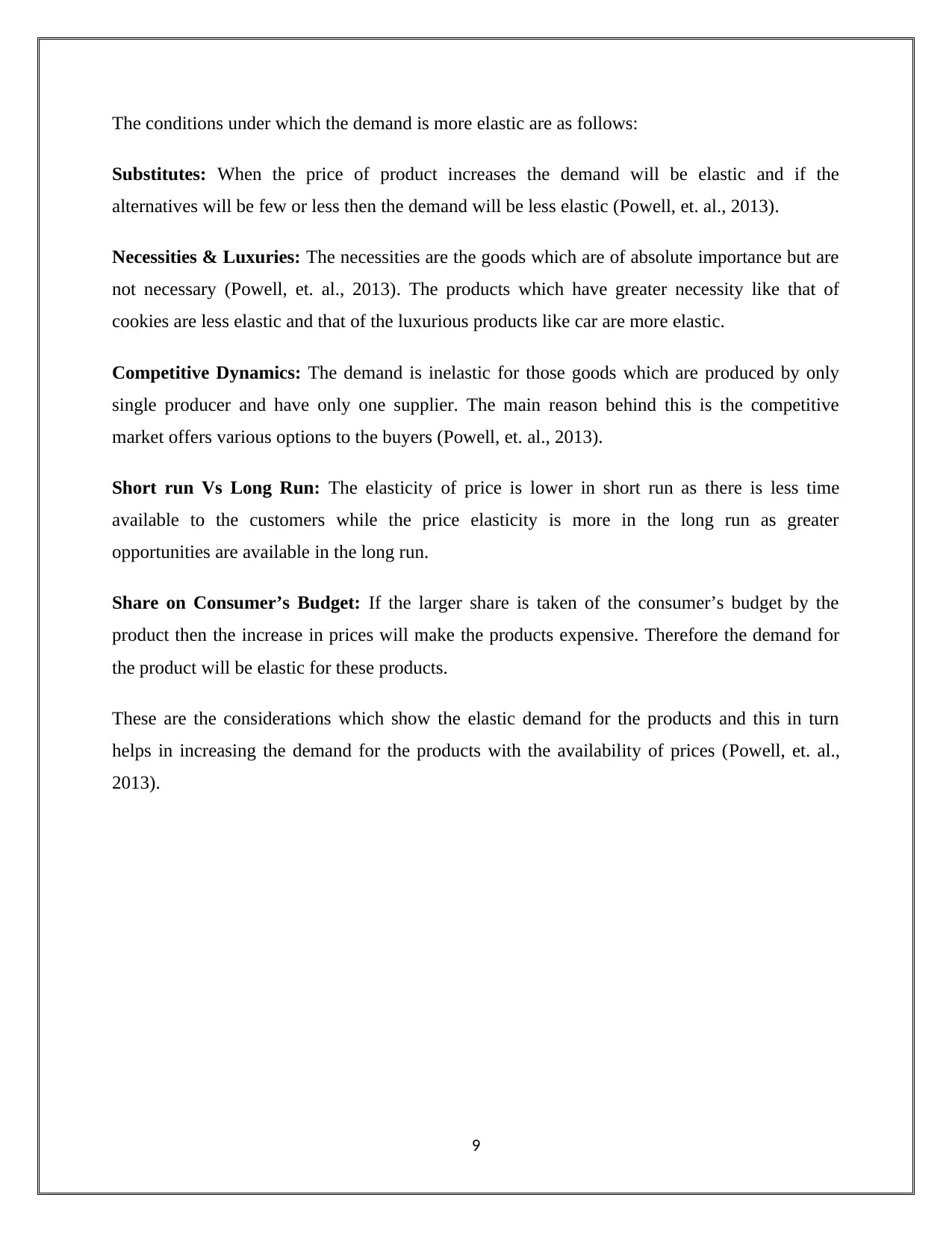
The conditions under which the demand is more elastic are as follows:
Substitutes: When the price of product increases the demand will be elastic and if the
alternatives will be few or less then the demand will be less elastic (Powell, et. al., 2013).
Necessities & Luxuries: The necessities are the goods which are of absolute importance but are
not necessary (Powell, et. al., 2013). The products which have greater necessity like that of
cookies are less elastic and that of the luxurious products like car are more elastic.
Competitive Dynamics: The demand is inelastic for those goods which are produced by only
single producer and have only one supplier. The main reason behind this is the competitive
market offers various options to the buyers (Powell, et. al., 2013).
Short run Vs Long Run: The elasticity of price is lower in short run as there is less time
available to the customers while the price elasticity is more in the long run as greater
opportunities are available in the long run.
Share on Consumer’s Budget: If the larger share is taken of the consumer’s budget by the
product then the increase in prices will make the products expensive. Therefore the demand for
the product will be elastic for these products.
These are the considerations which show the elastic demand for the products and this in turn
helps in increasing the demand for the products with the availability of prices (Powell, et. al.,
2013).
9
Substitutes: When the price of product increases the demand will be elastic and if the
alternatives will be few or less then the demand will be less elastic (Powell, et. al., 2013).
Necessities & Luxuries: The necessities are the goods which are of absolute importance but are
not necessary (Powell, et. al., 2013). The products which have greater necessity like that of
cookies are less elastic and that of the luxurious products like car are more elastic.
Competitive Dynamics: The demand is inelastic for those goods which are produced by only
single producer and have only one supplier. The main reason behind this is the competitive
market offers various options to the buyers (Powell, et. al., 2013).
Short run Vs Long Run: The elasticity of price is lower in short run as there is less time
available to the customers while the price elasticity is more in the long run as greater
opportunities are available in the long run.
Share on Consumer’s Budget: If the larger share is taken of the consumer’s budget by the
product then the increase in prices will make the products expensive. Therefore the demand for
the product will be elastic for these products.
These are the considerations which show the elastic demand for the products and this in turn
helps in increasing the demand for the products with the availability of prices (Powell, et. al.,
2013).
9
⊘ This is a preview!⊘
Do you want full access?
Subscribe today to unlock all pages.

Trusted by 1+ million students worldwide

4. What will happen to total revenue of a firm if it raises its price and its demand is elastic (or
inelastic).
If the price of the firm is increased so with the increased price the total revenue of the
organization will decrease (Aghaei and Alizadeh, 2013). There is the proper relation among the
price of goods, composite proceeds and the price elasticity of market demand. When the demand
is inelastic the rise in price will lead to the increase in total revenue of the products. For example,
the rise of 20% in the price will cause the decrease in demand by 5%. When the demand is
elastic reduce in prices will lead to increase in total revenue (Aghaei and Alizadeh, 2013).
Elasticity of Demand Price Total revenue
Elastic>1 Decrease
Increase
Increase
Decrease
Unitary PED=1 Decrease
Increase
No Change
No Change
Inelastic<1 Decrease
Increase
Decrease
Increase
This table shows the proper connection involving the elasticity of demand, price and total
revenue. If the demand is elastic the rise in price will show the decrease in total revenue of the
firm while the decrease in price shows the climb in entirety income (Aghaei and Alizadeh,
2013). Where the demand is inelastic the plunge in value will also show the fall in total revenue
of the products. While the rise in the price of the product will lead to the increase in total
revenue. Therefore, it can be said that the increase in price will also lead to the increase in total
revenue when the demand is inelastic. The price elasticity of demand helps in predicting the
change in cost and the whole revenues of the sellers. The total revenue test is done so as to
determine that the demand is elastic or inelastic. Hence, the increase in price will boost the total
revenue and the demand is said to be inelastic (Aghaei and Alizadeh, 2013).
10
inelastic).
If the price of the firm is increased so with the increased price the total revenue of the
organization will decrease (Aghaei and Alizadeh, 2013). There is the proper relation among the
price of goods, composite proceeds and the price elasticity of market demand. When the demand
is inelastic the rise in price will lead to the increase in total revenue of the products. For example,
the rise of 20% in the price will cause the decrease in demand by 5%. When the demand is
elastic reduce in prices will lead to increase in total revenue (Aghaei and Alizadeh, 2013).
Elasticity of Demand Price Total revenue
Elastic>1 Decrease
Increase
Increase
Decrease
Unitary PED=1 Decrease
Increase
No Change
No Change
Inelastic<1 Decrease
Increase
Decrease
Increase
This table shows the proper connection involving the elasticity of demand, price and total
revenue. If the demand is elastic the rise in price will show the decrease in total revenue of the
firm while the decrease in price shows the climb in entirety income (Aghaei and Alizadeh,
2013). Where the demand is inelastic the plunge in value will also show the fall in total revenue
of the products. While the rise in the price of the product will lead to the increase in total
revenue. Therefore, it can be said that the increase in price will also lead to the increase in total
revenue when the demand is inelastic. The price elasticity of demand helps in predicting the
change in cost and the whole revenues of the sellers. The total revenue test is done so as to
determine that the demand is elastic or inelastic. Hence, the increase in price will boost the total
revenue and the demand is said to be inelastic (Aghaei and Alizadeh, 2013).
10
Paraphrase This Document
Need a fresh take? Get an instant paraphrase of this document with our AI Paraphraser
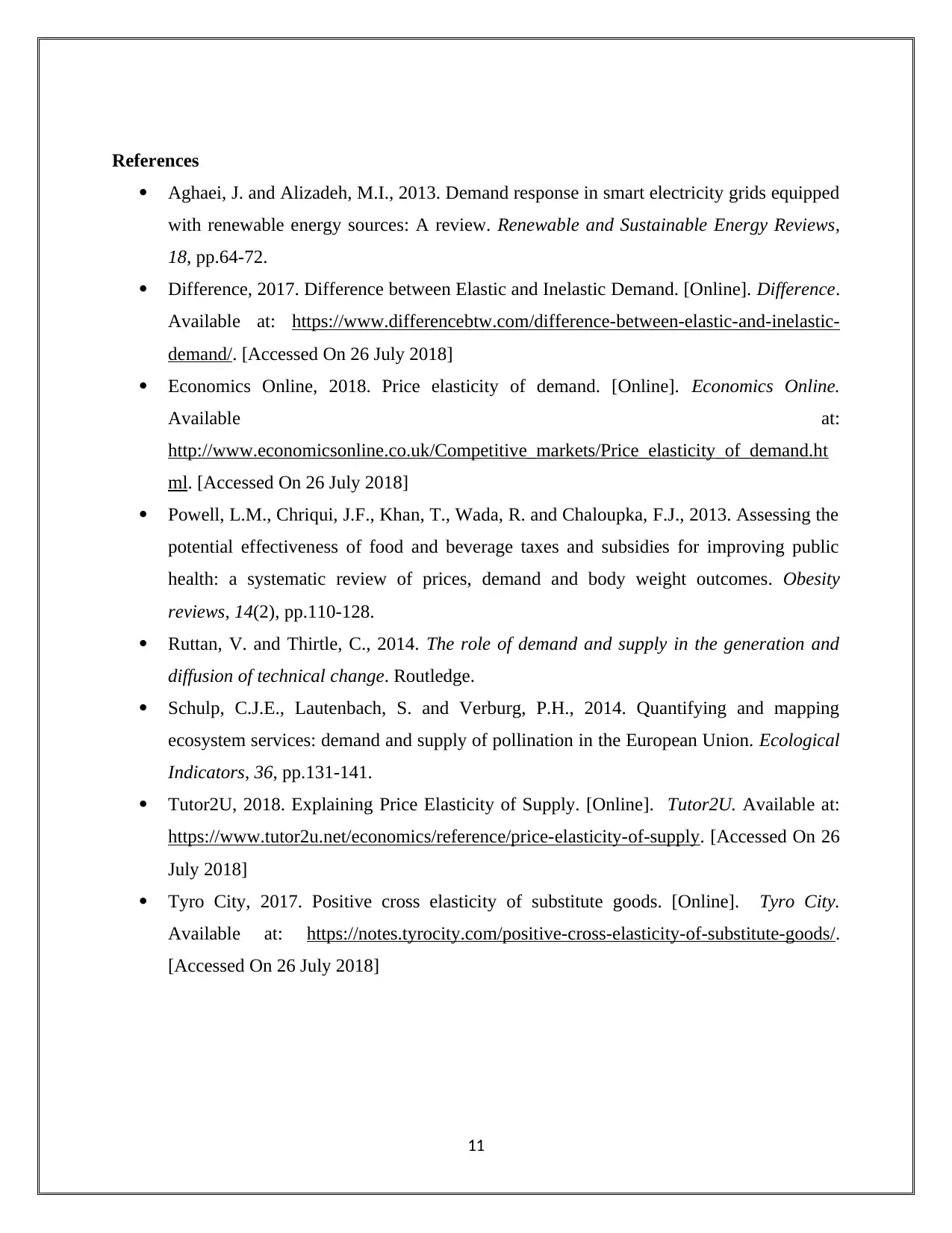
References
Aghaei, J. and Alizadeh, M.I., 2013. Demand response in smart electricity grids equipped
with renewable energy sources: A review. Renewable and Sustainable Energy Reviews,
18, pp.64-72.
Difference, 2017. Difference between Elastic and Inelastic Demand. [Online]. Difference.
Available at: https://www.differencebtw.com/difference-between-elastic-and-inelastic-
demand/. [Accessed On 26 July 2018]
Economics Online, 2018. Price elasticity of demand. [Online]. Economics Online.
Available at:
http://www.economicsonline.co.uk/Competitive_markets/Price_elasticity_of_demand.ht
ml. [Accessed On 26 July 2018]
Powell, L.M., Chriqui, J.F., Khan, T., Wada, R. and Chaloupka, F.J., 2013. Assessing the
potential effectiveness of food and beverage taxes and subsidies for improving public
health: a systematic review of prices, demand and body weight outcomes. Obesity
reviews, 14(2), pp.110-128.
Ruttan, V. and Thirtle, C., 2014. The role of demand and supply in the generation and
diffusion of technical change. Routledge.
Schulp, C.J.E., Lautenbach, S. and Verburg, P.H., 2014. Quantifying and mapping
ecosystem services: demand and supply of pollination in the European Union. Ecological
Indicators, 36, pp.131-141.
Tutor2U, 2018. Explaining Price Elasticity of Supply. [Online]. Tutor2U. Available at:
https://www.tutor2u.net/economics/reference/price-elasticity-of-supply. [Accessed On 26
July 2018]
Tyro City, 2017. Positive cross elasticity of substitute goods. [Online]. Tyro City.
Available at: https://notes.tyrocity.com/positive-cross-elasticity-of-substitute-goods/.
[Accessed On 26 July 2018]
11
Aghaei, J. and Alizadeh, M.I., 2013. Demand response in smart electricity grids equipped
with renewable energy sources: A review. Renewable and Sustainable Energy Reviews,
18, pp.64-72.
Difference, 2017. Difference between Elastic and Inelastic Demand. [Online]. Difference.
Available at: https://www.differencebtw.com/difference-between-elastic-and-inelastic-
demand/. [Accessed On 26 July 2018]
Economics Online, 2018. Price elasticity of demand. [Online]. Economics Online.
Available at:
http://www.economicsonline.co.uk/Competitive_markets/Price_elasticity_of_demand.ht
ml. [Accessed On 26 July 2018]
Powell, L.M., Chriqui, J.F., Khan, T., Wada, R. and Chaloupka, F.J., 2013. Assessing the
potential effectiveness of food and beverage taxes and subsidies for improving public
health: a systematic review of prices, demand and body weight outcomes. Obesity
reviews, 14(2), pp.110-128.
Ruttan, V. and Thirtle, C., 2014. The role of demand and supply in the generation and
diffusion of technical change. Routledge.
Schulp, C.J.E., Lautenbach, S. and Verburg, P.H., 2014. Quantifying and mapping
ecosystem services: demand and supply of pollination in the European Union. Ecological
Indicators, 36, pp.131-141.
Tutor2U, 2018. Explaining Price Elasticity of Supply. [Online]. Tutor2U. Available at:
https://www.tutor2u.net/economics/reference/price-elasticity-of-supply. [Accessed On 26
July 2018]
Tyro City, 2017. Positive cross elasticity of substitute goods. [Online]. Tyro City.
Available at: https://notes.tyrocity.com/positive-cross-elasticity-of-substitute-goods/.
[Accessed On 26 July 2018]
11

12
⊘ This is a preview!⊘
Do you want full access?
Subscribe today to unlock all pages.

Trusted by 1+ million students worldwide
1 out of 12
Related Documents
Your All-in-One AI-Powered Toolkit for Academic Success.
+13062052269
info@desklib.com
Available 24*7 on WhatsApp / Email
![[object Object]](/_next/static/media/star-bottom.7253800d.svg)
Unlock your academic potential
Copyright © 2020–2025 A2Z Services. All Rights Reserved. Developed and managed by ZUCOL.




